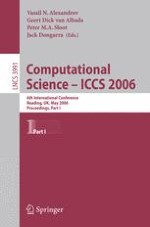2006 | Buch
Computational Science – ICCS 2006
6th International Conference, Reading, UK, May 28-31, 2006, Proceedings, Part I
herausgegeben von: Vassil N. Alexandrov, Geert Dick van Albada, Peter M. A. Sloot, Jack Dongarra
Verlag: Springer Berlin Heidelberg
Buchreihe : Lecture Notes in Computer Science
